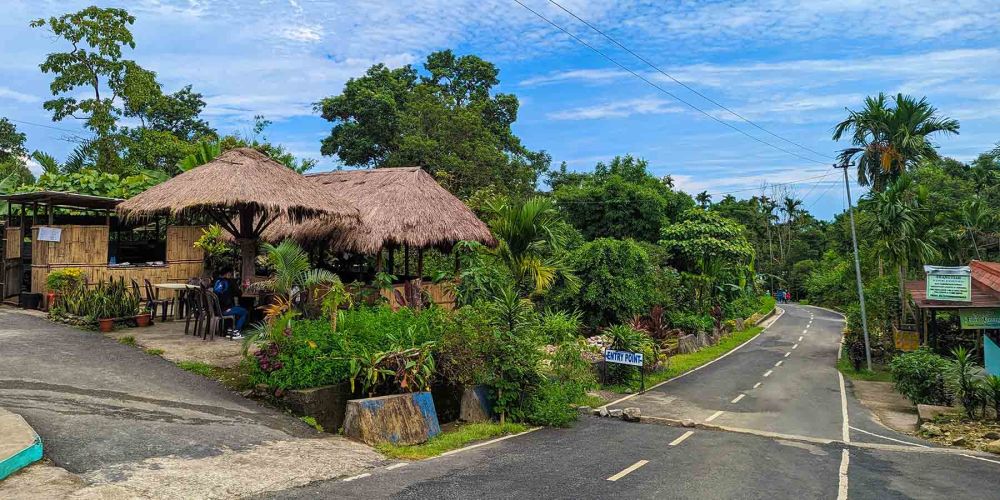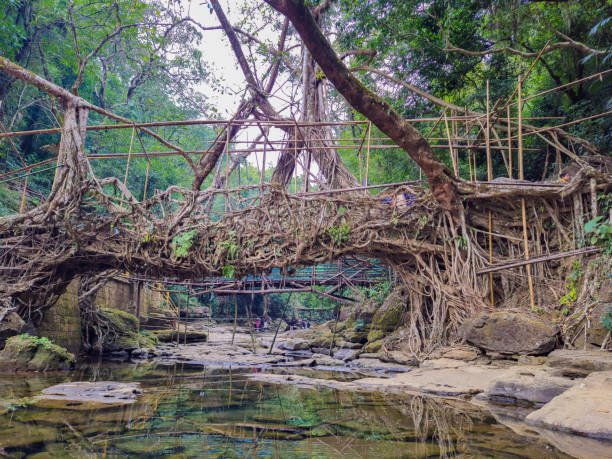Nestled in the East Khasi Hills of Meghalaya, India, lies a small village that has captured the attention of the world for its pristine cleanliness and environmental consciousness. Mawlynnong, often referred to as “God’s Own Garden,” has earned the prestigious title of Asia’s Cleanest Village. This remarkable accolade is not just a testament to the village’s beauty, but also to the deep-rooted values of its community, which have made cleanliness and sustainability a way of life.

Mawlynnong, home to about 500 residents, earned its reputation as Asia’s cleanest village in 2003 when Discover India magazine bestowed the title upon it. But the village’s journey towards cleanliness and sustainability began long before that.
The Journey to Cleanliness
Mawlynnong’s journey to becoming Asia’s Cleanest Village is an inspiring tale of community-driven efforts and a collective commitment to preserving the environment. For generations, the villagers of Mawlynnong have adhered to a strict code of cleanliness and environmental stewardship. Families pass down this ethos, and each generation takes pride in maintaining the village’s immaculate appearance.
The village’s cleanliness is evident from the moment you step foot in Mawlynnong. The streets are free of litter, with well-maintained pathways lined with flowering plants and bamboo dustbins placed at regular intervals. Plastic waste is virtually nonexistent, as the villagers have embraced sustainable practices, including composting and recycling.
The Role of Community
The heart of Mawlynnong’s success lies in its close-knit community. The villagers work together to keep the environment clean and green. Every family in the village participates in regular cleaning drives, where they sweep the streets, clear debris, and maintain the public spaces. Teachers teach children the importance of cleanliness from a young age, and they actively participate in these initiatives, instilling a lifelong respect for their surroundings in them.
Mawlynnong’s cleanliness is not just about keeping the village tidy; it’s a reflection of the community’s respect for nature. The villagers have a deep connection with the land, and this is evident in their sustainable practices. For instance, people widely practice rainwater harvesting, ensuring a steady supply of water and conserving this precious resource.
Education plays a crucial role in sustaining these practices. Teachers teach children the importance of hygiene and environmental conservation from a young age, fostering a generation that values and upholds these principles. The village also welcomes tourists, offering them a glimpse into their way of life and encouraging them to adopt similar practices in their own communities.
Mawlynnong boasts a 100% literacy rate, a remarkable achievement in a country where rural education often lags. The village school, supported by the community, ensures that every child receives an education.
Community-Driven Cleanliness
One of the most remarkable aspects of Mawlynnong is its community-driven approach to maintaining cleanliness. Every resident, from young children to older people, participates in regular cleaning drives. This sense of collective responsibility ensures that the village remains spotless and serves as an inspiration to visitors and neighboring communities. The secret behind Mawlynnong’s spotless streets and immaculate surroundings is the strong sense of community responsibility:
- Daily Cleaning Ritual: Every morning, villagers sweep the streets, collecting garbage in bamboo baskets.
- Waste Management: The village has an efficient waste segregation system. People use biodegradable waste for composting, while they properly dispose of other waste.
- Plastic Ban: The use of plastic bags is strictly prohibited in the village.
- Public Participation: Cleanliness is not just a government initiative but a way of life for every resident, regardless of age.
- Rainwater Harvesting: The village has an excellent rainwater harvesting system, ensuring water availability throughout the year.
- Eco-Friendly Toilets: Every house has a functional toilet, many of which are eco-friendly.
- Smoking and Betel Nut Chewing Ban: To maintain cleanliness and promote health, authorities ban these practices in public spaces.
Eco-Friendly Practices
In addition to its cleanliness, Mawlynnong is known for its eco-friendly practices that have helped it maintain its title as Asia’s Cleanest Village. The use of bamboo and other natural materials is prevalent in the construction of houses and other structures, reducing the carbon footprint. The village is also free of plastic bags, with residents opting for biodegradable alternatives instead.
Waste management is a key aspect of Mawlynnong’s environmental strategy. People compost organic waste and use it as fertilizer for the lush gardens and crops that surround the village. This not only helps in waste reduction but also promotes sustainable agriculture. The villagers’ efforts in maintaining an eco-friendly environment have made Mawlynnong a model for sustainable living.
Mawlynnong’s reputation for cleanliness is not just a superficial label; it is deeply ingrained in the daily lives of its residents. The village is adorned with bamboo dustbins at every corner, ensuring that waste is properly disposed of and recycled. Plastic bags are banned, and the use of organic composting is widespread, turning waste into valuable fertilizer for the lush gardens that dot the village.
The community’s dedication to cleanliness extends to its infrastructure. The streets are meticulously swept, and the houses are well-maintained, often decorated with vibrant flowers. A strong sense of pride and responsibility drives the villagers’ collective effort, viewing cleanliness as a core cultural value.
Tourism and Cultural Preservation
Mawlynnong’s reputation as Asia’s Cleanest Village has attracted tourists from around the world, eager to witness its cleanliness and experience the unique Khasi culture. The village’s natural beauty, combined with its well-preserved traditions, makes it a popular destination for eco-tourism. Lush greenery surrounds the village, with scenic views of the nearby Living Root Bridges and the breathtaking Sky View, a bamboo structure that provides panoramic views of the Bangladesh plains.
However, the influx of tourists has posed challenges for the village. The villagers have been careful to balance tourism with the preservation of their environment and culture. They have implemented measures to manage waste generated by visitors and encourage eco-friendly practices among tourists. Additionally, local guides educate visitors about the village’s customs and the importance of maintaining its cleanliness.
The village also offers homestays, allowing visitors to immerse themselves in the local way of life. Staying in Mawlynnong provides a firsthand experience of how the villagers live in harmony with nature, practicing sustainable living while preserving their cultural heritage. Tourists can purchase locally made handicrafts, supporting the village economy.
The Living Root Bridges
One of Mawlynnong’s most remarkable attractions is the living root bridges, a testament to the ingenuity and environmental harmony of the Khasi people. People make these natural bridges from the aerial roots of rubber trees, carefully guiding and weaving them over time to create sturdy, functional structures. Living root bridges stand as engineering marvels, symbolizing the community’s harmonious coexistence with nature.
Beyond its pristine environment, Mawlynnong offers a plethora of attractions. The living root bridges, ingeniously crafted by the villagers using the roots of rubber trees, are a marvel of nature and human ingenuity. Hiking through the lush landscapes, exploring the quaint bamboo huts, and interacting with the warm-hearted locals are experiences that leave an unforgettable mark.
The bridges take years, sometimes decades, to fully form, and they grow stronger over time. The villagers maintain these bridges, ensuring their longevity for future generations. The living root bridges are a perfect example of sustainable infrastructure, blending human ingenuity with natural processes.

The Legacy of Mawlynnong
People recognize Mawlynnong as Asia’s Cleanest Village, a shining example of what can be achieved when a community comes together with a shared vision of environmental stewardship. The village’s commitment to cleanliness, sustainability, and cultural preservation has not only brought it international acclaim but has also inspired other communities to adopt similar practices.
The story of Mawlynnong is a reminder that even the smallest of villages can make a significant impact on the world. It showcases how traditional values when combined with a modern understanding of environmental challenges, can create a sustainable and harmonious way of life. As Mawlynnong continues to inspire visitors and communities alike, it stands as a beacon of hope for a cleaner, greener future.
Mawlynnong is a shining example of how communities can come together to create a sustainable and beautiful living space. Its journey from an ordinary village to an international icon is an inspiration for us all. As we grapple with environmental challenges, Mawlynnong’s story reminds us that even small steps can make a significant difference.
TO LEARN MORE CLICK BELOW
- Agartala’s Flood Mitigation Project Honored at LBSNAA
- Mawsynram: Discover the Wettest Place in India and the World
- Umngot River: Meghalaya’s Crystal-Clear Gem
- India’s States and UTs: A Colorful Tapestry of Nicknames
- Agartala: A Model for Flood-Resilient Cities
- All about Meghalaya
- Foundation Day of States in India
- The Poisonous Red Pond of Odisha
- The Jatinga Mystery
- Sikkim Wins Best State Award for Environment Education
- Duckweed-Based Wastewater Treatment Systems
- What is Zero Shadow Day?
- Drylands: The Vital Lifeline for Over 2 Billion People
Frequently Asked Questions (FAQs)
A1: Mawlynnong is located in the East Khasi Hills district of Meghalaya, India. It is approximately 90 kilometers from the state capital, Shillong, and near the border with Bangladesh.
A2: Mawlynnong earned the title of Asia’s Cleanest Village due to its immaculate cleanliness, well-maintained public spaces, and community-driven efforts to keep the environment litter-free. People know the village for its sustainable practices, such as waste management and the absence of plastic waste.
A3: Key attractions in Mawlynnong include the living root bridges, and natural wonders created by guiding the roots of rubber trees to form functional bridges. The village itself is a beautiful sight, with flower-lined streets and bamboo houses. The nearby viewpoint offers stunning views of the Bangladesh plains.
A4: Mawlynnong villagers practice composting, rainwater harvesting, and the use of biodegradable materials. They avoid plastic, using bamboo dustbins and natural materials in construction. People compost organic waste and use it as fertilizer for local gardens and crops.
A5: The villagers maintain the cleanliness of Mawlynnong through regular community cleaning drives, in which they all participate. Each family keeps their surroundings clean, and teachers teach children the importance of cleanliness from a young age.
A6: Yes, tourists are welcome to visit Mawlynnong. The village offers homestays for visitors to experience local life. However, local authorities encourage tourists to respect the village’s cleanliness and participate in eco-friendly practices during their stay.






